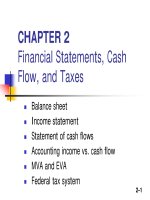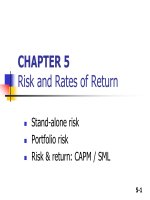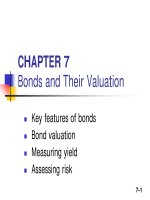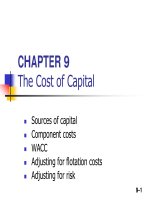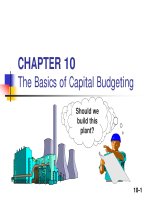Slide strategic financial management l07
Bạn đang xem bản rút gọn của tài liệu. Xem và tải ngay bản đầy đủ của tài liệu tại đây (1.22 MB, 26 trang )
Strategic
Strategic Financial
Financial Management
Management
MEASURING RETURN ON INVESTMENTS
Khuram Raza
ACMA, Ms Finance
First Principle and Big Picture
What is a project?
Capital Budgeting?
The process of identifying, analyzing, and selecting investment projects whose returns (cash flows)
are expected to extend beyond one year.
Project analyzed in capital budgeting has three criteria:
a large up-front cost,
cash flows for a specific time period, and
a salvage value at the end, which captures the value of the assets of the project when the
project ends.
What is a project?
ect
Defined broadly then, any of the following decisions would qualify as projects:
Proj
dent
Major strategic decisions to enter new areas of business
Acquisitions of new equipment , building or other firms
Decisions on new ventures within existing businesses or markets
Decisions that may change the way existing ventures and projects are run
Decisions on how best to deliver a service that is necessary for the business to run smoothly.
pen
Inde
ects
Proj
e
usiv
Excl
y
uall
Mut
s
nue
reve
e
erat
gen
to
ect
proj
s
cost
ce
redu
to
ect
proj
Hurdle rates for projects
Project Characteristics
Project is small and has characteristics similar to the firm
Cost of Equity: Project Risk similar within business, Firm’s beta
Cost of Equity: Proxy business Beta, Bottom up Beta
Cost of Equity: Assess the project risk independently, Bottom up Beta
Cost of Debit: Firm’s cost of debt
Project is large and has characteristics different from the firm
Cost of Debt: cost of debt of the comparable firms
Stand-alone Project
Cost of Debt: cost of debt of the Project
Measuring Returns: The Choices
A. Accounting Earnings versus Cash Flows
Why are accounting earnings different from cash flows?
Operating versus Capital Expenditure
Add back all non-cash charges, such as depreciation and amortization, to the operating earnings
Non-Cash Charges
Accrual versus Cash Revenues and Expenses
From Accounting Earnings to Cash flows
Subtract out all cash outflows that represent capital expenditures
Net out the effect of changes in non-cash working capital, i.e. changes in accounts receivable, inventory and
accounts payable.
Measuring Returns: The Choices
B. Total versus Incremental Cash Flows
Sunk Costs
Allocations of fixed expenses, such as general and administrative costs
C. Time-Weighted versus Nominal Cash Flows
Prefer present consumption to future consumption
Inflation
Uncertainty (risk)
Measuring Returns: The Choices
Basic characteristics of relevant project flows
Cash (not accounting income) flows
Operating (not financing) flows
After-tax flows
Incremental flows
Principles that must be adhered to in the estimation
Ignore sunk costs
Include opportunity costs
Include project-driven changes in working capital net of spontaneous
changes in current liabilities
Include effects of inflation
Investment Decision Rules
Accounting Income Based Decision Rules
Earnings before interest and taxes (1- tax rate)
Return on Capital =
Average Book Value of Total Investment in Project
Net Income
Return on Equity=
Average Book Value of Equity Investment in Project
Cash Flow Based Decision Rules
Payback
The payback on a project is a measure of how quickly the cash
flows generated by the project cover the initial investment
0
–40 K
1
10 K
2
12 K
3
15 K
4
10 K
5
7K
Julie Miller is evaluating a new project for her firm, Basket Wonders (BW). She
has determined that the after-tax cash flows for the project will be $10,000;
$12,000; $15,000; $10,000; and $7,000, respectively, for each of the Years 1
through 5. The initial cash outlay will be $40,000.
Payback
Payback Solution
Solution (#1)
(#1)
0
(-b)
–40 K
1
2
10 K
12 K
10 K
Cumulative
Inflows
PBP
(a) 4
3
22 K
15 K
37 K
=a+(b–c)/d
= 3 + (3) / 10
10 K
(c) 47 K
5
(d)
7K
54 K
= 3 + (40 – 37) / 10
= 3.3 Years
Payback
Payback Solution
Solution (#2)
(#2)
–40 K
–30 K
0
1
2
3
4
5
–40 K
10 K
12 K
15 K
10 K
7K
–18 K
PBP
Cumulative
Cash Flows
–3 K
7K
= 3 + ( 3K ) / 10K
14 K
= 3.3 Years
Note: Take absolute value of last negative cumulative cash flow value.
PBP
PBP Acceptance
Acceptance Criterion
Criterion
The management of Basket Wonders has set a maximum PBP of 3.5 years
for projects of this type.
Should this project be accepted?
Yes! The firm will receive back the initial cash outlay in less than 3.5 years. [3.3
Years < 3.5 Year Max.]
Limitations
By restricting itself to answering the question
“When will this project make its initial
investment?” it ignores what happens after the initial investment is recouped.
The payback rule is designed to cover the conventional project that involves a large up-front
investment followed by positive operating cash flows.
The payback rule uses nominal cash flows and counts cash flows in the early years the same
as cash flows in the later years.
Internal
Internal Rate
Rate of
of Return
Return (IRR)
(IRR)
IRR is the discount rate that equates the present value of the future net cash flows
from an investment project with the project’s initial cash outflow.
ICO =
CF1
+
1
(1 + IRR)
CF2
(1 + IRR)
CFn
2
+...+
(1 + IRR)
n
IRR
IRR Solution
Solution
$40,000 =
$10,000
(1+IRR)
$15,000
+
3
(1+IRR)
1
$12,000
+
2
(1+IRR)
$10,000
(1+IRR)
4
+
$7,000
+
5
(1+IRR)
Find the interest rate (IRR) that causes the discounted cash flows to equal $40,000.
IRR
IRR Solution
Solution (Try
(Try 10%)
10%)
$40,000 =
$10,000(PVIF10%,1) + $12,000(PVIF10%,2) +
$10,000(PVIF10%,4) +
$40,000 =
$15,000(PVIF10%,3) +
$ 7,000(PVIF10%,5)
$10,000(0.909) + $12,000(0.826) +
$15,000(0.751) + $10,000(0.683) +
$ 7,000(0.621)
$40,000 =
$9,090 + $9,912 + $11,265 +
= $41,444
[Rate is too low!!]
$6,830 + $4,347
IRR
IRR Solution
Solution (Try
(Try 15%)
15%)
$40,000 =
$10,000(PVIF15%,1) + $12,000(PVIF15%,2) +
$10,000(PVIF15%,4) +
$40,000 =
$15,000(PVIF15%,3) +
$ 7,000(PVIF15%,5)
$10,000(0.870) + $12,000(0.756) +
$15,000(0.658) + $10,000(0.572) +
$ 7,000(0.497)
$40,000 =
$8,700 + $9,072 + $9,870 +
= $36,841
[Rate is too high!!]
$5,720 + $3,479
IRR
IRR Solution
Solution (Interpolate)
(Interpolate)
5%
10%
15%
$40,000
$41,444
$1,444
-$ 3,159 $36,841
$ 4,603
16% +- 3,159
10%
1,444
x
5%
4,603
11.57%
IRR
IRR Acceptance
Acceptance Criterion
Criterion
The management of Basket Wonders has determined that the hurdle rate is
13% for projects of this type.
Should this project be accepted?
No! The firm will receive 11.57% for each dollar invested in this project at a
cost of 13%. [ IRR < Hurdle Rate ]
IRR
IRR Strengths
Strengths
and
and Weaknesses
Weaknesses
Strengths:
• Accounts for
• Considers all
TVM
cash flows
Weaknesses:
• Assumes all cash
at
flows reinvested
the IRR
• Difficulties with
Multiple IRRs
project rankings and
Net
Net Present
Present Value
Value (NPV)
(NPV)
NPV is the present value of an investment project’s net cash flows
minus the project’s initial cash outflow.
NPV =
CF1
+
1
(1+k)
CF2
2
(1+k)
CFn
+...+
n
(1+k)
- ICO
NPV
NPV Solution
Solution
Basket Wonders has determined that the appropriate discount rate (k) for this
project is 13%.
NPV =
$10,000
+
1
(1.13)
$10,000
(1.13)
4
$12,000 $15,000
+
2
3
(1.13)
(1.13)
$7,000
+
(1.13)
5
- $40,000
+
NPV
NPV Solution
Solution
NPV =
$10,000(PVIF13%,1) + $12,000(PVIF13%,2) +
$10,000(PVIF13%,4) +
NPV =
$15,000(PVIF13%,3) +
$ 7,000(PVIF13%,5) – $40,000
$10,000(0.885) + $12,000(0.783) +
$15,000(0.693) + $10,000(0.613) +
$ 7,000(0.543) – $40,000
NPV =
=
$8,850 + $9,396 + $10,395 +
- $1,428
$6,130 + $3,801 – $40,000
NPV
NPV Acceptance
Acceptance Criterion
Criterion
The management of Basket Wonders has determined that the required rate
is 13% for projects of this type.
Should this project be accepted?
No! The NPV is negative. This means that the project is reducing shareholder
wealth. [Reject as NPV < 0 ]


